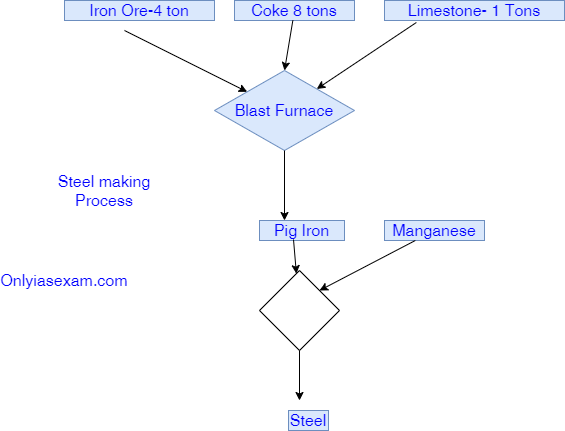Table of Contents:
- Previous Years UPSC question
- Characteristics
- Historical background
- Modern Steel TISCO
- Process of steelmaking
- Location factor
- Distribution of Iron and Steel
- Production-wise country
Previous Years UPSC question:
- Examine critically the factors for the localization of the iron and steel industry in India with special reference to the newer centers of steel production. (1995)
- Discuss the growth, location, and distribution of iron and steel industries in India. (2000)
- Examine the role of raw materials in the location of the Iron and Steel Industry in India. Illustrate your answer with suitable examples( 2009)
- “The Bokaro Iron and Steel Plant is an example of an Industrial Complex.” Explain. (2016)
Characteristics of Iron and Steel Industry:
- The iron and steel industry forms the base of all other industries, it is also called the primary industry.
- It is a heavy industry because of the usage of a large quantity of bulky raw material, as well as produces bulky finished goods.
- It is a type of mineral-based industry as it uses minerals as raw materials
- It is a large-scale industry as requires large capital and technology as well as labor.
Historical Background of Iron and Steel Industry:
Indian "Wootz Steel" was specialized steel during Tipu Sultan's time over South India
More about Wootz Steel:
- Incredible hard
- A special type of high carbon steel
- Made up by smelting furnace
- The skill of making Wootz steel was completely lost by the mid-nineteen century.
Various reason leads to the decline of steel crafts:
- Armor making Industry died
- Steel import from England
- Ban on forest products and taxing on forest leads to unavailability of wood for charcoal making
A modern Steel factory in India:
- Jamshed Ji Tata installed modern steel factories at Jamshedpur because of its close proximity to Rajhara iron ore mines; one of the finest iron ore mines in the world.
- Water source from the Subarnrekha river provides sufficient water
- TISCO started in 1907 and began production in 1912
- World wars and railways helped Tata to grow and expand its Steel plants.
Process of Iron and Steel Industry
The following diagram shows the process of stell making:
- Close to Raw Materials:
- Iron Ore
- Coal
- Manganese
- Limestones
- Power
- Water
- Cheap Labour
- Port Accessibility
- Transport and communication
Mini steel mill; from scrap metal
Distribution of Iron and steel industry in India:
The following location has steel industries.
- Jamshedpur
- Kulti Burnpur
- Durgapur
- Raurkela
- Bhilai
- Bokaro
- Salem
- Visakhapatanam
- Bhadrawati
In the second five-year plan; between 1956 to 1961, three steel plants were established under Hindustan Steel Limited( HSL).
- Rourkela with the help of Germany.
- Bhilai with the help of Russia
- Durgapur with the help of the UK.
In 1964, the Bokaro steel plant was established with the help of Russia.
In 1973, the Steel Authority of India Limited was formed and nearly all the major public sector steel plants came under this.
A major producer of iron and steel :
- China
- India
- Japan
- USA
- Russia
China produces more than 50 % of world production.
You may like the following post also:
- Evolution of industries
- Classification of Industries
- Factors affecting the location of Industries
- Locational factors of cotton Industry | Cotton Industry in India
- Locational factors of Jute Industry | Jute Industry in India
- Iron and Steel Industry| Evolution of Iron and Steel Industry
- Aluminium Industry
- Fertilizer Industry
- Paper Industry
- Chemical Industry
- Petrochemical Industry
- Pharmaceutical industry
- Automobile industry
- Cottage industry
- Agro-based industries
- Industrial houses and complexes including public sector undertakings
- Industrial regionalization
- New industrial policies
- Multinationals and liberalization
- Special Economic Zones
- Tourism including eco-tourism
- Petro-Chemical Industrial in India
- Status of different types of tourism in India

ConversionConversion EmoticonEmoticon